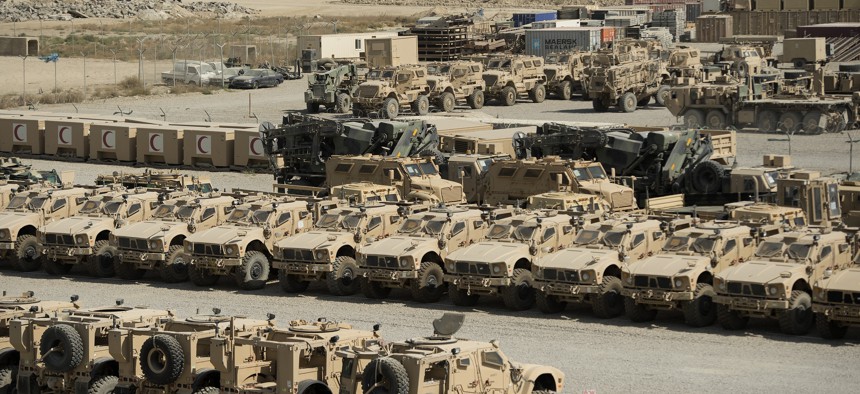
Military vehicles and accessory equipment sit in a retrograde yard at Bagram Airfield, Afghanistan before being shipped out of the country By MSgt Benjamin Bloker (Public domain), via Wikimedia Commons
Getting Out of Afghanistan Isn't Getting Any Easier
Just months before its December drawdown deadline, the military’s retrograde operations still face considerable hurdles
With Afghanistan presidential rivals Ashraf Ghani and Abdullah Abdullah agreeing to a power-sharing deal that bodes well for the all-important U.S.-Afghanistan Bilateral Security Agreement, the U.S. military can get back to worrying about the last major piece of its drawdown puzzle - actually getting out. Retrograde (the military’s term for reverse logistics) has been going on for years, but, with the December 2014 deadline quickly approaching, it is now crunch time for “the biggest single military logistical undertaking ever.” Since its 2011 peak of 101,000 troops, the U.S. has drawn down to 30,700 at the beginning of September and will shrink to 9,800 by the end of the year. Concurrently, the U.S.-NATO coalition has dismantled more than 750 bases and returned, destroyed, or transferred tens of thousands of vehicles and pieces of equipment since 2011. DoD estimates the cost of this drawdown to be $5.7 billion.
The end may be in sight, but there still remain significant challenges to a successful drawdown. Three in particular stand out:
Withdrawing from an active war zone - U.S. casualties have fallen markedly in the last two years, but the Taliban’s 2014 summer offensive demonstrates that they are from a defeated entity. Retrograde operations are therefore complicated (and made more expensive) by the need to actively protect departing forces and equipment vulnerable to attack. This comes to a head when removing the very weapons and equipment used for such protection. Speaking about the difficulty of quickly extracting by helicopter an M777 Howitzer artillery piece used as defensive cover at a Forward Operating Base in Paktia province, an Army Sergeant told the Washington Post, “I have seen guns get dragged across the fire point, I have seen guns become lawn darts, I have seen guns cut loose from the helicopter by a nervous crew chief at 20-feet in the air. Most of our guys have never had an opportunity to do this before, and it can be very dangerous if something goes wrong.”
Geopolitical constraints - Ensuring safe supply routes into Afghanistan has been a major challenge for the U.S. military since 2001. Afghanistan is landlocked, has an unforgiving geography, has an underdeveloped infrastructure, and resides in a geopolitically contentious part of the world. It is this last constraint that has proven most variable and frustrating, particularly in relation to Pakistan. In response to U.S. drone strikes and alleged incursions across the border, Pakistan twice shut down the Pakistan Ground Lines of Communication (PAKGLOC) the military relies on in the last three years. Now, Islamabad is engaged in an “all-out offensive” against tribal militants in the Federally Administered Tribal Areas, a north western region bordering Afghanistan, that may impede this important U.S. retrograde route. General Paul Selva, Commander of U.S. Transportation Command, admitted as much in an interview with Defense News. He said that U.S forces have been able to use the southern route through Pakistan, but that the northern route through the Khyber Pass is “a little bit more problematic” in the wake of the Pakistani military’s operations.
Inadequate equipment tracking - If the Army’s experience is any indication, the military is struggling to keep track of the equipment it is moving out of Afghanistan. An April 2014 DoD Inspector General report concluded that the Redistribution Property Assistance Teams (RPATs) the Army designated to manage equipment to be destroyed, redistributed, and retrograded have failed to sufficiently account for and safeguard this equipment. Between May 2012 and May 2013, 37.2% of equipment moving through RPAT yards in Bagram and Kandahar was not properly tracked, resulting in $586.7 million in accumulated losses, including weapons and other sensitive items.
These three challenges suggest the military’s final stages of withdrawal from Afghanistan will be as dangerous, uncertain, and costly as ever. But unlike the first two hurdles, the military controls its ability to track and safeguard its own equipment. Inadequately doing so has likely cost the Pentagon billions and potentially provided enemies with valuable equipment. Senior DoD employees themselves have acknowledged the problem: A recent GBC study found that 63% of senior DoD employees surveyed think that information collection on DoD equipment could, in general, be improved. In the coming months, as Pentagon planners reflect on the military’s largest ever logistical operation, they might look for ways to enhance the visibility of military equipment.
This post is written by Government Business Council; it is not written by and does not necessarily reflect the views of Government Executive Media Group's editorial staff. For more information, see our advertising guidelines.